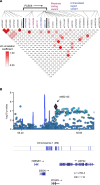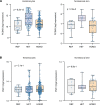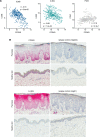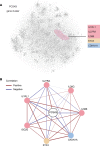Proprotein convertase subtilisin/kexin type 9 is a psoriasis-susceptibility locus that is negatively related to IL36G
- PMID: 35862195
- PMCID: PMC9462487
- DOI: 10.1172/jci.insight.141193
Proprotein convertase subtilisin/kexin type 9 is a psoriasis-susceptibility locus that is negatively related to IL36G
Abstract
Proprotein convertase subtilisin/kexin type-9 (PCSK9) is a posttranslational regulator of the LDL receptor (LDLR). Recent studies have proposed a role for PCSK9 in regulating immune responses. Using RNA-Seq-based variant discovery, we identified a possible psoriasis-susceptibility locus at 1p32.3, located within PCSK9 (rs662145 C > T). This finding was verified in independently acquired genomic and RNA-Seq data sets. Single-cell RNA-Seq (scRNA-Seq) identified keratinocytes as the primary source of PCSK9 in human skin. PCSK9 expression, however, was not uniform across keratinocyte subpopulations. scRNA-Seq and IHC demonstrated an epidermal gradient of PCSK9, with expression being highest in basal and early spinous layer keratinocytes and lowest in granular layer keratinocytes. IL36G expression followed the opposite pattern, with expression highest in granular layer keratinocytes. PCSK9 siRNA knockdown experiments confirmed this inverse relationship between PCSK9 and IL36G expression. Other immune genes were also linked to PCSK9 expression, including IL27RA, IL1RL1, ISG20, and STX3. In both cultured keratinocytes and nonlesional human skin, homozygosity for PCSK9 SNP rs662145 C > T was associated with lower PCSK9 expression and higher IL36G expression, when compared with heterozygous skin or cell lines. Together, these results support PCSK9 as a psoriasis-susceptibility locus and establish a putative link between PCSK9 and inflammatory cytokine expression.
Keywords: Autoimmunity; Clinical practice; Dermatology; Skin.
Figures








Similar articles
-
Proprotein convertase subtilisin kexin type 9 (PCSK9) secreted by cultured smooth muscle cells reduces macrophages LDLR levels.Atherosclerosis. 2012 Feb;220(2):381-6. doi: 10.1016/j.atherosclerosis.2011.11.026. Epub 2011 Nov 25. Atherosclerosis. 2012. PMID: 22176652
-
β-Estradiol results in a proprotein convertase subtilisin/kexin type 9-dependent increase in low-density lipoprotein receptor levels in human hepatic HuH7 cells.FEBS J. 2015 Jul;282(14):2682-96. doi: 10.1111/febs.13309. Epub 2015 May 18. FEBS J. 2015. PMID: 25913303 Free PMC article.
-
Diverse Effects of Cilostazol on Proprotein Convertase Subtilisin/Kexin Type 9 between Obesity and Non-Obesity.Int J Mol Sci. 2022 Aug 29;23(17):9768. doi: 10.3390/ijms23179768. Int J Mol Sci. 2022. PMID: 36077166 Free PMC article.
-
Targeting the proprotein convertase subtilisin/kexin type 9 for the treatment of dyslipidemia and atherosclerosis.J Am Coll Cardiol. 2013 Oct 15;62(16):1401-8. doi: 10.1016/j.jacc.2013.07.056. Epub 2013 Aug 21. J Am Coll Cardiol. 2013. PMID: 23973703 Review.
-
Antitumor activity and molecular mechanism of proprotein convertase subtilisin/kexin type 9 (PCSK9) inhibition.Naunyn Schmiedebergs Arch Pharmacol. 2022 Jun;395(6):643-658. doi: 10.1007/s00210-022-02200-y. Epub 2022 Mar 21. Naunyn Schmiedebergs Arch Pharmacol. 2022. PMID: 35307759 Review.
Cited by
-
Immune disease dialogue of chemokine-based cell communications as revealed by single-cell RNA sequencing meta-analysis.bioRxiv [Preprint]. 2024 Jul 19:2024.07.17.603936. doi: 10.1101/2024.07.17.603936. bioRxiv. 2024. PMID: 39071425 Free PMC article. Preprint.
-
Transcription Factor IRF7 is Involved in Psoriasis Development and Response to Guselkumab Treatment.J Inflamm Res. 2024 Feb 15;17:1039-1055. doi: 10.2147/JIR.S450048. eCollection 2024. J Inflamm Res. 2024. PMID: 38375022 Free PMC article.
-
Significance of Neutrophil Gelatinase-Associated Lipocalin (NGAL) and Proprotein Convertase Subtilisin/Kexin Type 9 (PCSK9) for the Monitoring of Treatment Response to Cyclosporine in Patients with Psoriasis.Life (Basel). 2023 Sep 6;13(9):1873. doi: 10.3390/life13091873. Life (Basel). 2023. PMID: 37763277 Free PMC article.
-
Genome-wide identification of dysregulated alternative splicing and RNA-binding proteins involved in atopic dermatitis.Front Genet. 2024 Mar 1;15:1287111. doi: 10.3389/fgene.2024.1287111. eCollection 2024. Front Genet. 2024. PMID: 38495671 Free PMC article.
-
CASZ1 Is Essential for Skin Epidermal Terminal Differentiation.J Invest Dermatol. 2024 Sep;144(9):2029-2038. doi: 10.1016/j.jid.2024.02.014. Epub 2024 Mar 6. J Invest Dermatol. 2024. PMID: 38458428 Free PMC article.
References
Publication types
MeSH terms
Substances
Grants and funding
LinkOut - more resources
Full Text Sources
Medical
Molecular Biology Databases
Miscellaneous

